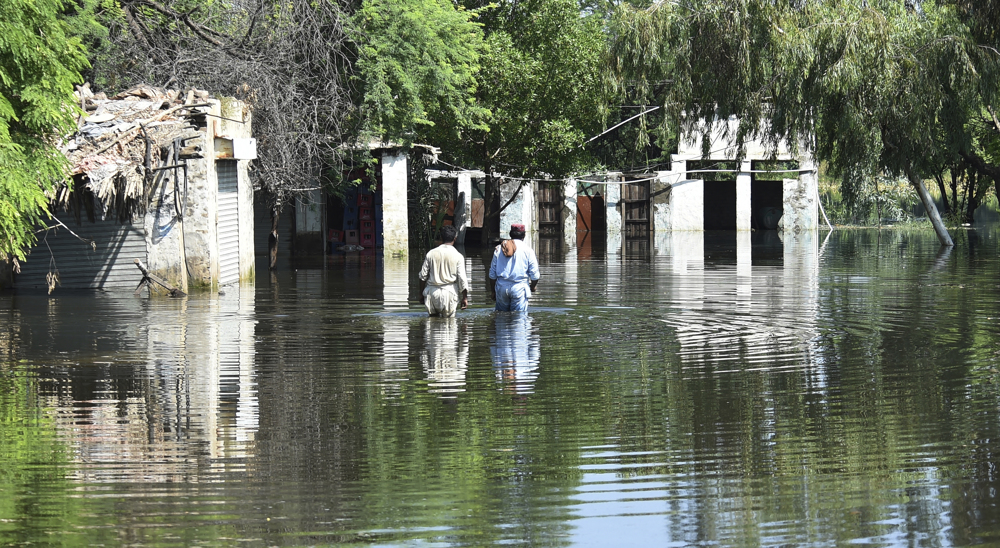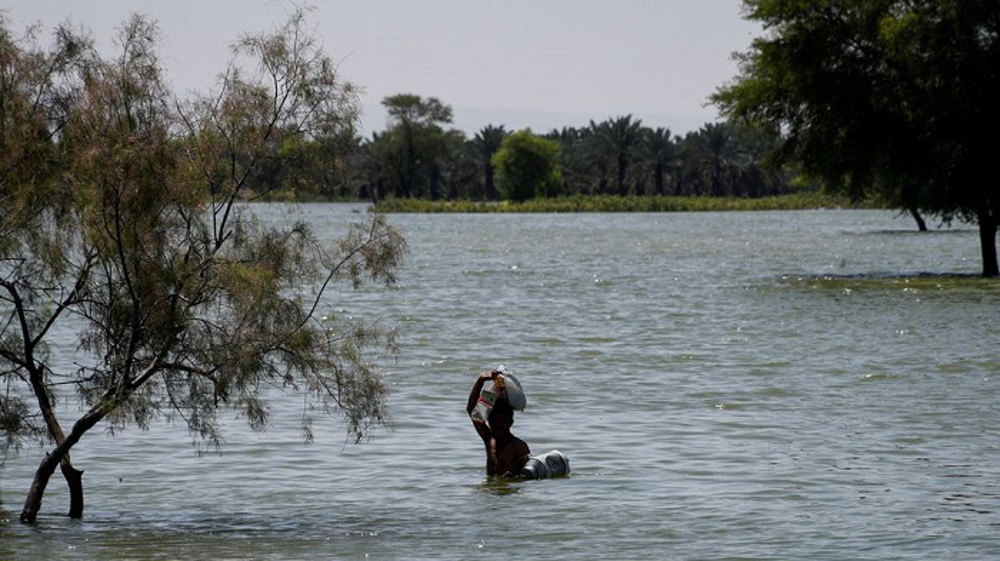Flood-hit Pakistan breaches largest freshwater lake to save more densely populated areas from overflow
Authorities in flood-hit Pakistan have strategically breached the country's largest freshwater lake, a minister says, displacing up to 100,000 people from their homes but saving more densely populated areas from gathering flood water.
Record monsoon rains and melting glaciers in Pakistan's northern mountains have brought floods that have affected 33 million people and killed at least 1,290, including 453 children. The inundation, blamed on climate change, is still spreading.
Manchar Lake, which is used for water storage, had already reached dangerous levels, and the increased pressure posed a threat to surrounding areas in the country's southern Sindh province, Sindh Irrigation Minister Jam Khan Shoro said.
He said about 100,000 people would be affected by the breach in five councils, but it would help save more populated clusters and also help reduce water levels in other, harder-hit areas.
"By inflicting the breach we have tried to save Sehwan town. Water levels on Johi and Mehar towns in Dadu district would be reduced by this breach in the lake," Shoro told Reuters on Sunday.
It was not clear how many of the 100,000 asked to leave their homes would actually do so.
Aside from historic rainfall, southern Pakistan has had to contend with increased flooding as a surge of water flowed down the Indus river.
The country has already received nearly three times the 30-year average rainfall in the quarter through August, totaling 390.7 millimeters (15.38 inches). Sindh province, with a population of 50 million, was hardest hit, getting 464% more rain than the 30-year average.
Being downstream on the Indus river, the southern parts of the country have witnessed swelling river waters flowing from the north. Pakistan's limited dams and reservoirs are already overflowing and cannot be used to stop downstream flows.
Tarbela dam in the north-west, has been at capacity - 1,550 feet and 5.8 million acre feet - for weeks, according to NDMA data.
Downstream in Sindh, barrages are under pressure with the Indus river in high flood level, the NDMA said in its latest situation report.
Warning of more floods in Pakistan as lake swells from monsoon rains
Officials in Pakistan have warned that more flooding was expected as Lake Manchar in the south of the country swelled from unprecedented monsoon rains that have resulted in the deaths of nearly 1,300 people.
Meteorologists predicted more rain in the region in the coming days and authorities urged villagers in the Jamshoro and Dadu districts of Sindh province near the lake to evacuate. The rising waters reached dangerous levels and posed a threat to a protective dyke and embankment, they said. The lake, located west of the Indus River, is the largest natural freshwater lake in Pakistan and one of the largest in Asia.
Fariduddin Mustafa, administrator for the Jamshoro district, said on Sunday that officials made a cut into the lake’s embankment to allow excess water to escape and ultimately flow into the Indus but the water was continuing to rise.

Mustafa said, “After we assessed water levels had reached a dangerous level … and there was fear that the embankment of the lake might be caved in at any time, the administration decided to make a cut on the Bagh-e-Yousuf side to avert any uncontrollable flow of water.”
The development came a day after Pakistan appealed again to the international community for aid to victims of the flooding that has left millions homeless around the country. Planes from multiple countries have been bringing supplies to the country across a humanitarian air bridge.
Multiple officials and experts have blamed the unusual monsoon rains and flooding on climate change, including the UN secretary general, Antonio Guterres, who last week called on the world to stop “sleepwalking” through the deadly crisis. He will visit Pakistan on 9 September to tour flood-hit areas and meet officials.
In its latest report, Pakistan’s National Disaster Management Authority put the death toll since mid-June – when monsoon rains started weeks earlier this year – at 1,290 as more fatalities were reported from flood affected areas of Sindh, Khyber Pakhtunkhwa and Baluchistan provinces.
The authority said relief and rescue operations continued on Sunday with troops and volunteers using helicopters and boats to get people stranded out of flooded areas to relief camps where they were being provided shelter, food and health care.
Relief camps have been set up in government buildings servicing tens of thousands of people while thousands more have taken shelter on roadsides on higher ground.
According to initial government estimates, the devastation has caused $10bn (£8.6bn) in damage but the planning minister, Ahsan Iqbal, said on Saturday “the scale of devastation is massive and requires an immense humanitarian response for 33 million people.”
The renewed request for international aid came as Pakistan received 30 planes with relief goods from Turkey, China, UAE, France, Uzbekistan and other countries with more planes expected in the coming days.
Two members of the US Congress, Sheila Jackson and Tom Suozzi, were expected to arrive in Pakistan on Sunday to visit the flood-affected areas and meet officials.
(Source: Agencies)
VIDEO | Iran's Leader backs legitimate protests in address on Social Justice
VIDEO | Press TV's news headlines
Hamas: Israel escalating ceasefire violations in Gaza
Venezuela's government declares unwavering unity behind Maduro
VIDEO | Global outcry over Venezuela president abduction
Iran keeps wheat import subsidies despite cutting other food supports
Venezuelan military stands with acting president after US kidnapping of Maduro
VIDEO | Press TV's news headlines










 This makes it easy to access the Press TV website
This makes it easy to access the Press TV website